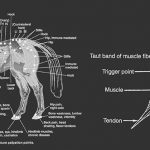Hypertonicity
The word hypertonicity relates to water leaving a cell due to a higher concentration of solutes outside of the cell. It is also used to described the state of resting muscle tension in horses where a specific muscle or group of muscles are continually left in a state of increased tension. Hypertonicity is a big issue for horses and commonly develops when the horse is shifting weight from a painful region such as a joint in a lower limb. This hypertonicity function has developed through the evolution of the horse in the wild and throughout domestication, it allows the horse to keep on the move whilst nursing an injury. This survival mechanism differentiates the horse from predatory animals such as humans and dogs. Because of this muscle tightening response there is a lesser degree of lameness associated with soft tissue injuries such as a muscle tear which could cause a much more dramatic lameness in a human or a greyhound.
This function can however become an issue for performance horses, particularly if the muscle is left in a hypertonic state for extended periods of time, as the muscle shortens it’s strength and length is decreased significantly. This limits performance and also asserts pressure and stress onto other tissues and structures allowing injury to manifest away from the primary region, this makes detection of soft tissue injuries in horses much more complicated.
On inspection of the horse with muscle hypertonicity there is a tightening and reactivity to palpation which is temporarily relieved by compressions on the muscle and stretching. In a muscle which is in spasm from a strain or tear the muscle will not respond to the compressive palpation and stretching. This is because in the hypertonic muscle, contracture is only in the muscle fibres and not in the connective tissues, this therefore allows for easier release of the muscle.
Hypertonic muscles contain less intra cellular water, contain higher levels of lactic acid, have reduced vascularization and reduced movement in the fascia (the muscle coating). After time toxins build up in the muscle, these muscle fibres are reduced and replaced by fibrous tissue in a process called fibrosis. This process takes away the contractile power of the muscle and restricts muscle lengthening which has a major impact on the movement of the body.
The cause of prolonged hypertonicity is not actually in the muscle, it is a nerve dysfunction in the spinal cord. To understand the cause it is important to look at the role of the nervous system in maintaining posture and movement. The motor activity of the muscle is controlled by the pyramidal and extrapyramidal tracts of spinal cord which originate from the motor cortex, basal ganglia and the brain stem. These tracts descend the spinal cord to innervate a reflex arch associated with their muscle of innovation.
Each muscle has a reflex arch which consists of a muscle spindle, a proprioceptive nerve, a motor nerve and a neuromuscular junction. Muscle tension is picked up by the muscle spindle in the belly of the muscle, this triggers a nerve impulse into the sensory proprioceptive nerve, this nerve then enters the dorsal horn of the spinal cord where the nerve impulse synapse with it’s associated motor nerve, this impulse is then transferred into the muscle through the motor nerve and it’s neuromuscular junction to cause the muscle fibres to contract. Through the reflex arch this unconscious function helps maintain muscle tone in both posture and in movement.
A neurotransmitter imbalance in the spinal cord can disrupt the inhibiting effect of the descending spinal motor nerves on this reflex arch, when this occurs the reflex arch is constantly switched on which causes uncontrolled muscle activity and muscle spasticity known as hypertonicity. It is however known in humans that lesions can occur along the descending tract which also inhibits it’s effect on the reflex arch, this may also occur in horses with chronic hypertonicity. Lesions which occur in the motor cortex, basal ganglia and the brain stem will cause more wide spread hypertonicity through out the body and not just in a specific muscle.
Treatment for hypertonicity can be difficult with western medicine as drugs which have an effect on spinal cord neurotransmitters tend to target the whole spine and not just the area of the spine associated with the hypertonic muscle’s reflex arch. This is why acupuncture has such a dramatic result on the specific muscles and reflex arches involved with the hypertonicity. Through knowledge of the acupuncture meridians in the body the acupuncturist can help to balance and reset neurotransmitter dysfunctions associated with the hypertonic muscle.
Acupuncture has been shown to enhance the release of opioids such as encephalin in the dorsal horn which are believed to cause presynaptic inhibition of these sensory nerves in the reflex arch.




